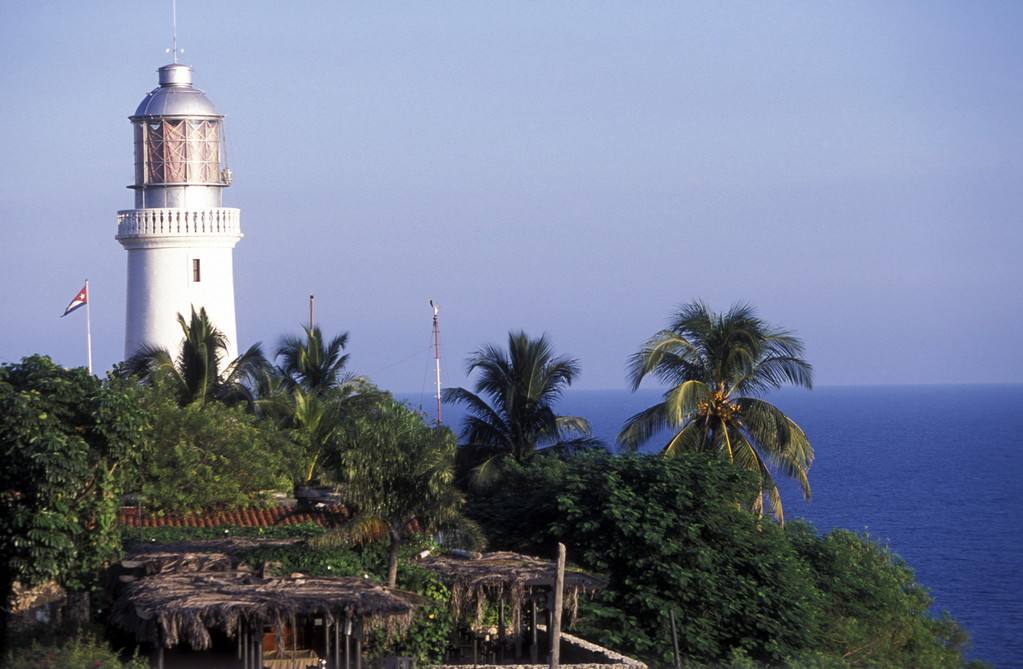4. Santiago de Cuba
4.圣地亞哥
Located on the eastern half of Cuba's island,
圣地亞哥位于古巴東部半島,
Santiago de Cuba is the country's second largest city and a scintillating cultural showpiece.
古巴第二大城市的圣地亞哥閃爍著文化之光。
Top rate museums document various episodes from Cuba's turbulent past
一流的博物館記錄了古巴動(dòng)蕩的過去,
whilst grand old architecture stands testament as the stage for many of these same episodes.
而雄偉的古老建筑則作為舞臺見證了其中許多類似的歷史。

The grandiose Santa Ifigenia cemetery is now the resting place for many of the city's very own revolutionaries
宏麗的圣伊菲熱尼亞公墓現(xiàn)在是這個(gè)城市本地許多革命者的安息地。
and Santiago has also produced its fair share of the country's best contemporary musicians.
圣地亞哥還培養(yǎng)出了相當(dāng)一部分古巴當(dāng)代最優(yōu)秀的音樂家。
In fact, the sensuous streets of Santiago are no doubt home to every genre of Cuban music available
實(shí)際上,圣地亞哥的感性街道無疑是各種古巴音樂的誕生地。
and the cosmopolitan city has a very distinct feel to it with a variety of cultural influences,
這個(gè)國際大都市由于受到各種文化的影響,所以給人一種非常獨(dú)特的感覺。
namely Caribbean as it's home to the country's largest Afro-Caribbean population.
美其名曰“加勒比風(fēng)情”,因?yàn)檫@里是古巴加勒比黑人的最大聚居地。
Every July carnival celebrations showcase this colourful mix of people with infectious drum rhythms and dance.
每年七月的狂歡節(jié)慶典就是這個(gè)多彩群體的舞臺,他們敲擊著令人心動(dòng)的鼓點(diǎn)節(jié)奏,跳著具有感染力的舞蹈。
5. Baracoa
5.巴拉科阿
Perched on the far eastern tip of Cuba,
巴拉科阿位于古巴的最東端,
the tiny coastal town of Baracoa is perhaps one of the most picturesque places in the country.
這座海邊小鎮(zhèn)也許是古巴最風(fēng)景如畫的地方之一了。
Enveloped by lush tropical vegetation with many rivers leading to a beautiful bay on the Atlantic,
巴拉科阿籠罩在茂密的熱帶植被之下,它有許多河流通向美麗的大西洋海灣,
the town has enjoyed years of relative solitude and up until 1964 the only way to reach Baracoa was via the sea.
這個(gè)鎮(zhèn)子多年來一直相對與世隔絕,1964以前,到達(dá)巴拉科亞的唯一途徑是航海。
Its remoteness has not meant a lack of history though
但地理位置上的偏僻并不意味著缺乏歷史的積淀,
and the town retains a rich heritage as one of the oldest colonial cities in the Americas.
且巴拉科阿是美國人最早的殖民城市之一,因此留有豐富的文化遺產(chǎn)。
Originally a small fishing and farming village,
巴拉科阿原本是一個(gè)農(nóng)業(yè)小漁村,
today Baracoa offers the intrepid traveller plenty of things to see and do with hiking,
如今的巴拉科阿為勇敢的游客提供了眾多觀賞之地以及與徒步旅行相關(guān)的項(xiàng)目活動(dòng),
white-water rafting and boating all on the menu.
還有竹筏漂流和劃船項(xiàng)目。
There's even an UNESCO Biosphere Reserve that protects one of the world's last untouched rainforests
甚至還有一個(gè)聯(lián)合國教科文組織的生物圈保護(hù)區(qū),保護(hù)著世界上最后一片未被破壞的雨林,
and plenty of tranquil beaches to simply relax and enjoy this wonderful town at leisure.
還有許多能讓人純粹放松且能在閑暇之余享受這座美麗小鎮(zhèn)的寧靜海灘。
6. Santa Clara
6.圣克拉拉
In the most central region of the country,
圣克拉拉位于古巴的正中部地區(qū),
the thriving university city of Santa Clara was once at the heart of the Cuban Revolution;
這座欣欣向榮的大學(xué)城曾一度是古巴的革命中心;
it was here that guerrilla leader Che Guevara led his troops into the final battle of the revolution,
游擊隊(duì)隊(duì)長切·格瓦拉就是在這里帶領(lǐng)著他的隊(duì)伍進(jìn)入了革命的最后一戰(zhàn),
resulting in the overthrow of Dictator Fulgencio Batista and the start of a new era.
這場戰(zhàn)爭推翻了獨(dú)裁者巴提斯塔,開啟了一個(gè)新時(shí)代。
Bohemian student cafes juxtapose with handsome colonial buildings and ghostly reminders of the city's complex history.
波希米亞的學(xué)生咖啡館與美麗的殖民建筑的并存,總讓人聯(lián)想到這座城市復(fù)雜的歷史。
Visit the Che Guevara Monument and Mausoleum, a memorial to those who gave their lives to the revolution
參觀切·格瓦拉紀(jì)念碑和紀(jì)念堂,紀(jì)念那些為革命獻(xiàn)出生命的人,
and the location of the revolutionary theorist's remains.
而且那里也是革命理論家遺骸的所在之地。
Travellers can also visit the Monumento a la Toma del Tren Blindado,
游客們也可以參觀裝甲車紀(jì)念碑,
the site where a military train carrying supplies was derailed during the historic battle.
這里是歷史戰(zhàn)爭中一列運(yùn)載補(bǔ)給的軍用火車脫軌的地方。











